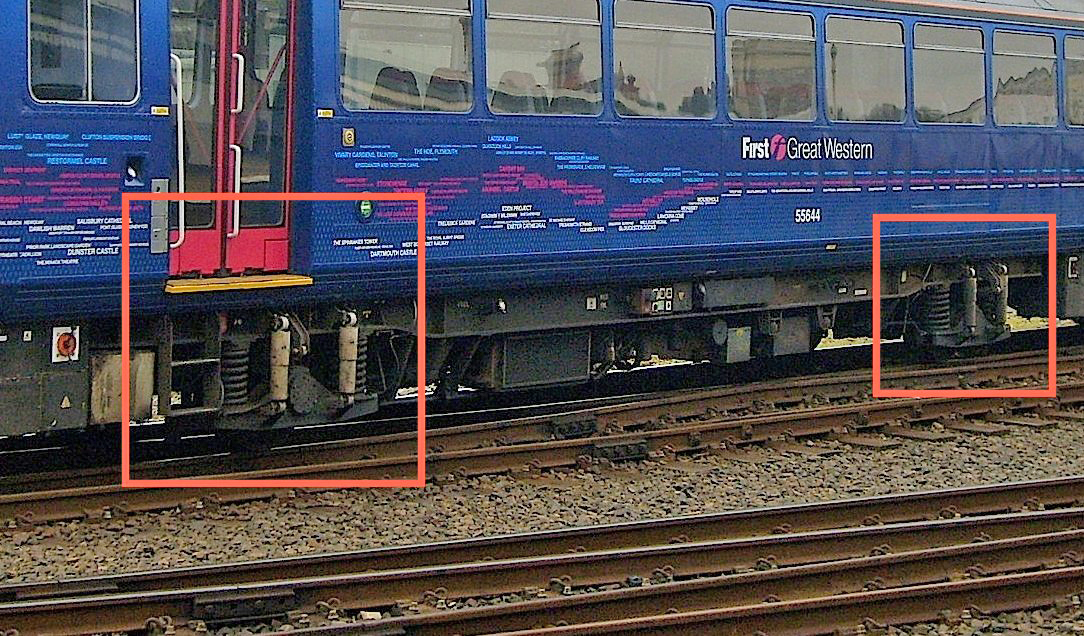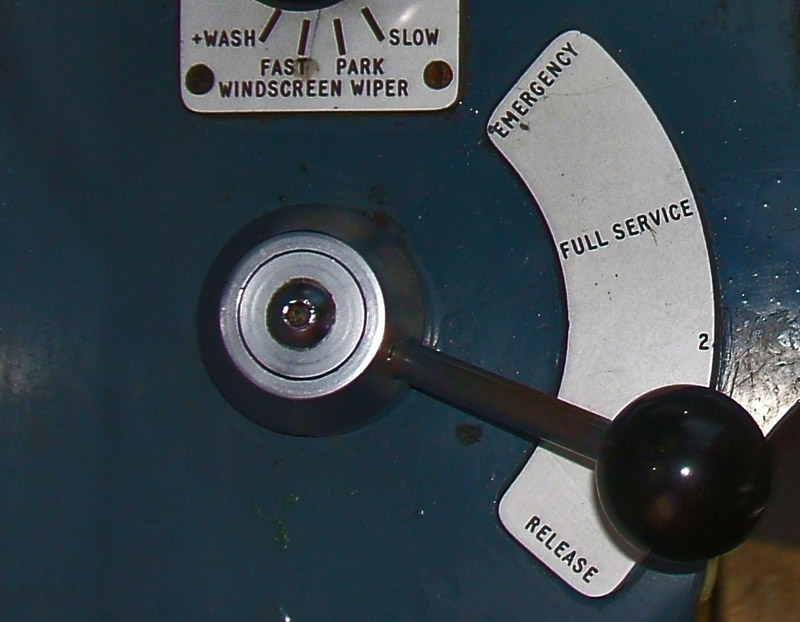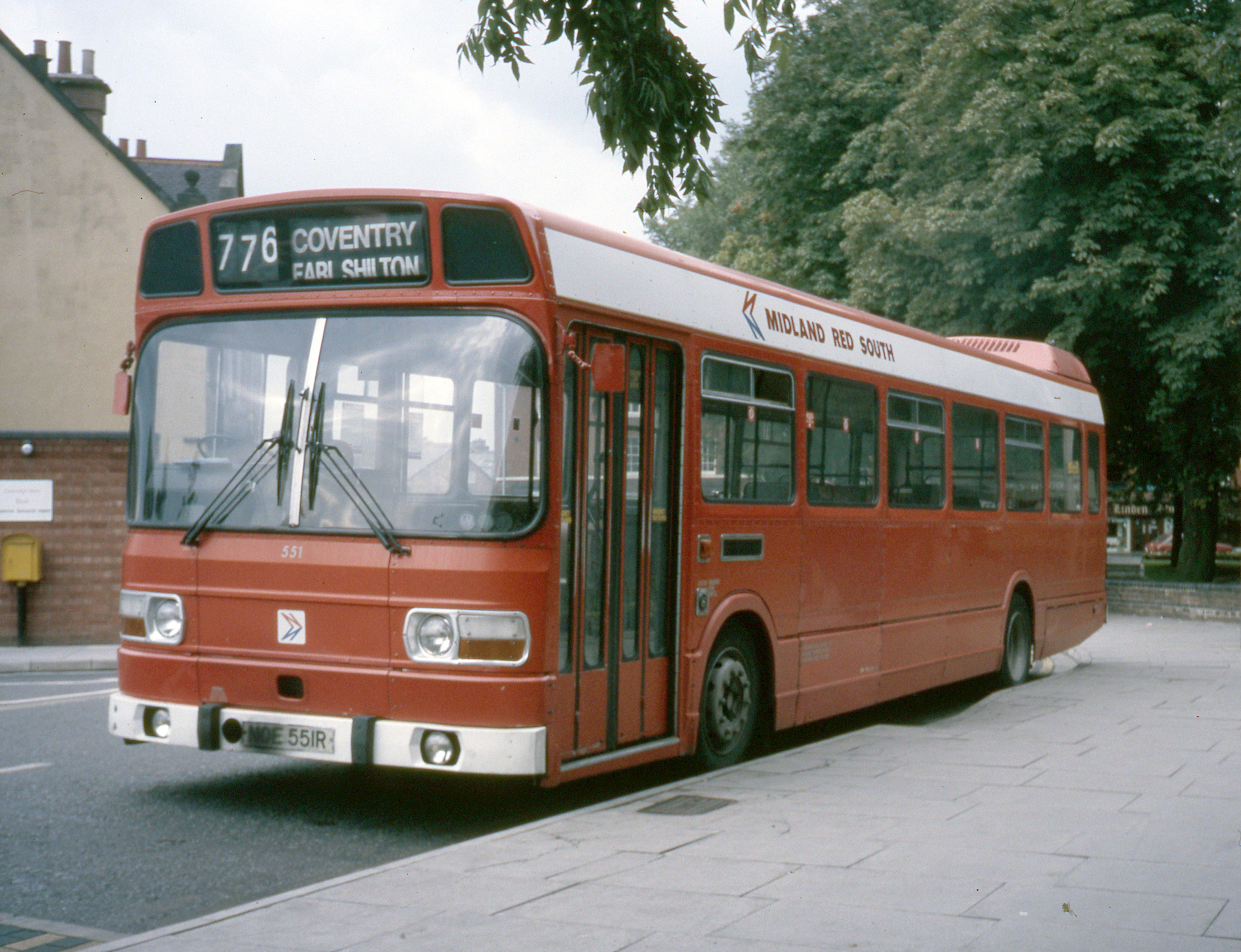|
British Rail Class 143
The British Rail Class 143 is a diesel multiple unit railbus, part of the Pacer family of passenger trains introduced between 1985 and 1986. During the 1980s, British Rail (BR) was interested in replacing its first-generation diesel multiple units, particularly in the use of railbuses to service its lightly used branch lines. It was decided to develop such a vehicle with a high level of commonality with the widely used Leyland National bus, leading to its modular design serving as the basis for the design. Several single and two-car prototypes were constructed and evaluated, leading to an initial production batch by British Leyland, designated as the Class 141 units. BR, seeking to procure improved derivatives of the Class 141, placed an order with the manufacturers Hunslet-Barclay and Walter Alexander to construct its own variant, the Class 143. Entering operational service during the mid-1980s, the Class 143 embodied several advances over the original model in terms of ri ... [...More Info...] [...Related Items...] OR: [Wikipedia] [Google] [Baidu] |
Great Western Railway (train Operating Company)
Great Western Railway (GWR) is a British train operating company owned by FirstGroup that operates the Greater Western passenger railway franchise. It manages 197 stations and its trains call at over 270. GWR operates long-distance inter-city services along the Great Western Main Line to and from the West of England and South Wales, inter-city services from London to the West Country via the Reading–Taunton line, and the ''Night Riviera'' sleeper service between London and Penzance. It also provides commuter and outer-suburban services from its London terminus at Paddington to West London, the Thames Valley region including parts of Berkshire, parts of Buckinghamshire and Oxfordshire; and regional services throughout the West of England and South Wales to the South coast of England. Great Western Railway also provides and maintains the Electrostar Class 387 fleet for Heathrow Express. The company began operating in February 1996 as Great Western Trains, as part of the pr ... [...More Info...] [...Related Items...] OR: [Wikipedia] [Google] [Baidu] |
Electro-pneumatic Brake System On British Railway Trains
The electro-pneumatic brake system on British mainline railway trains was introduced in 1950 and remains the primary braking system for multiple units in service today, although London Transport underground trains had been fitted with EP brakes since the 1920s. The Southern Region of British Railways operated a self-contained fleet of electric multiple units for suburban and middle-distance passenger trains. From 1950, an expansion of the fleet was undertaken and the new build adopted a braking system that was novel in the UK, the electro-pneumatic brake in which compressed air brake operation was controlled electrically by the driver. This was a considerable and successful technical advance, enabling a quicker and more sensitive response to the driver's operation of brake controls. Origins From the 1920s, the Southern Railway of the UK and its predecessor companies had adopted electrification and multiple-unit train operation as a solution for dense and intensive passenger ser ... [...More Info...] [...Related Items...] OR: [Wikipedia] [Google] [Baidu] |
Asbestos
Asbestos () is a naturally occurring fibrous silicate mineral. There are six types, all of which are composed of long and thin fibrous crystals, each fibre being composed of many microscopic "fibrils" that can be released into the atmosphere by abrasion and other processes. Inhalation of asbestos fibres can lead to various dangerous lung conditions, including mesothelioma, asbestosis, and lung cancer, so it is now notorious as a serious health and safety hazard. Archaeological studies have found evidence of asbestos being used as far back as the Stone Age to strengthen ceramic pots, but large-scale mining began at the end of the 19th century when manufacturers and builders began using asbestos for its desirable physical properties. Asbestos is an excellent electrical insulator and is highly fire-resistant, so for much of the 20th century it was very commonly used across the world as a building material, until its adverse effects on human health were more widely acknowledged ... [...More Info...] [...Related Items...] OR: [Wikipedia] [Google] [Baidu] |
KeolisAmey Wales
Keolis Amey Operations ( cy, Gweithrediadau KeolisAmey), Full legal name is bilingual including the Welsh name, as "Keolis Amey Operations / Gweithrediadau Keolis Amey Limited". trading as Transport for Wales Rail Services (TfW Rail Services) was a Welsh train operating company owned by Keolis (60%) and Amey (40%) that operated the Wales & Borders franchise between October 2018 and February 2021. The Welsh Government body Transport for Wales awarded the contract for the Wales and Borders franchise to KeolisAmey in 2018 which commenced rail operations on 14 October 2018. KeolisAmey used the brand names Transport for Wales and TfW Rail ( cy, Trafnidiaeth Cymru and ), which are owned by the Welsh Government, for day-to-day operations. The Welsh Government nationalised the franchise on 7 February 2021, transferring operations to Transport for Wales Rail, although KeolisAmey continues to provide an infrastructural role in the franchise. History In October 2016 four bids were ... [...More Info...] [...Related Items...] OR: [Wikipedia] [Google] [Baidu] |
British Rail Class 141
The British Rail Class 141 was the first production model of the ''Pacer'' diesel multiple unit (DMU) railbus. During the 1980s, British Rail (BR) was interested in replacing its first generation diesel multiple units, particularly in the use of railbuses to service its lightly used branch lines. It was decided to develop such a vehicle with a high level of commonality with the widely used Leyland National bus, leading to its modular design serving as the basis for the design. Several single and two-car prototypes were constructed and evaluated, before an order was placed with British Leyland for twenty two-car Class 141 units during 1984. During their operating lives, the units were tasked with various passenger services across the UK for 13 years. Following withdrawal, a large portion of the units were exported to Iran where they operated for a further eight years, giving the Class 141 a total lifespan of 21 years. Background By the beginning of the 1980s, British Rail (BR) o ... [...More Info...] [...Related Items...] OR: [Wikipedia] [Google] [Baidu] |
Leyland National
The Leyland National is an integrally-constructed British step-floor single-decker bus manufactured in large quantities between 1972 and 1985. It was developed as a joint project between two UK nationalised industries – the National Bus Company and British Leyland. Buses were constructed at a specially built factory at the Lillyhall Industrial Estate, Workington. Styling was carried out by the Italian vehicle stylist Giovanni Michelotti, previously commissioned by both Triumph (Herald, TR4, GT6, 2000/2500, 1300, Dolomite and Stag) and Scammell lorries (Routeman GRP cab). It was intended to replace all the rear-engined single-decker buses offered by British Leyland, including the AEC Swift, Bristol RE, single-deck Daimler Fleetline, Daimler Roadliner and Leyland Panther. Design The Leyland National was built with integral, modular construction and a rear engine. All components were designed for ease of construction and replacement. Until 1978, it was always built ... [...More Info...] [...Related Items...] OR: [Wikipedia] [Google] [Baidu] |
British Rail
British Railways (BR), which from 1965 traded as British Rail, was a state-owned company that operated most of the overground rail transport in Great Britain from 1948 to 1997. It was formed from the nationalisation of the Big Four British railway companies, and was privatised in stages between 1994 and 1997. Originally a trading brand of the Railway Executive of the British Transport Commission, it became an independent statutory corporation in January 1963, when it was formally renamed the British Railways Board. The period of nationalisation saw sweeping changes in the railway. A process of dieselisation and electrification took place, and by 1968 steam locomotives had been entirely replaced by diesel and electric traction, except for the Vale of Rheidol Railway (a narrow-gauge tourist line). Passengers replaced freight as the main source of business, and one-third of the network was closed by the Beeching cuts of the 1960s in an effort to reduce rail subsidies. On privatis ... [...More Info...] [...Related Items...] OR: [Wikipedia] [Google] [Baidu] |
Train
In rail transport, a train (from Old French , from Latin , "to pull, to draw") is a series of connected vehicles that run along a railway track and Passenger train, transport people or Rail freight transport, freight. Trains are typically pulled or pushed by locomotives (often known simply as "engines"), though some are self-propelled, such as multiple units. Passengers and cargo are carried in railroad cars, also known as wagons. Trains are designed to a certain Track gauge, gauge, or distance between rails. Most trains operate on steel tracks with steel wheels, the low friction of which makes them more efficient than other forms of transport. Trains have their roots in wagonways, which used railway tracks and were Horsecar, powered by horses or Cable railway, pulled by cables. Following the invention of the steam locomotive in the United Kingdom in 1804, trains rapidly spread around the world, allowing freight and passengers to move over land faster and cheaper than ever pos ... [...More Info...] [...Related Items...] OR: [Wikipedia] [Google] [Baidu] |
Railbus
A railbus is a lightweight passenger railcar that shares many aspects of its construction with a bus, typically having a bus (original or modified) body and four wheels on a fixed base, instead of on bogies. Originally designed and developed during the 1930s, railbuses have evolved into larger dimensions, with characteristics similar in appearance to a light railcar, with the terms ''railcar'' and ''railbus'' often used interchangeably. Railbuses designed for use specifically on little-used railway lines were commonly employed in countries such as Germany, Italy, France, the United Kingdom and Sweden. Today, railbuses are being replaced by modern light DMU railcar designs. Modern diesel-electric railcars, which can be run coupled as multiple units, like the Stadler RS1, the RegioSprinter of Siemens or the successor Siemens Desiro share role and specifications with railbuses (albeit with improvements in noise, low floor design, fuel efficiency, speed and other measures) but ... [...More Info...] [...Related Items...] OR: [Wikipedia] [Google] [Baidu] |
Diesel Multiple Unit
A diesel multiple unit or DMU is a multiple-unit train powered by on-board diesel engines. A DMU requires no separate locomotive, as the engines are incorporated into one or more of the carriages. Diesel-powered single-unit railcars are also generally classed as DMUs. Diesel-powered units may be further classified by their transmission type: diesel–mechanical DMMU, diesel–hydraulic DHMU, or diesel–electric DEMU. Design The diesel engine may be located above the frame in an engine bay or under the floor. Driving controls can be at both ends, on one end, or in a separate car. Types by transmission DMUs are usually classified by the method of transmitting motive power to their wheels. Diesel–mechanical In a diesel–mechanical multiple unit (DMMU), the rotating energy of the engine is transmitted via a gearbox and driveshaft directly to the wheels of the train, like a car. The transmissions can be shifted manually by the driver, as in the great majority of first-gen ... [...More Info...] [...Related Items...] OR: [Wikipedia] [Google] [Baidu] |
Sprinter (British Rail)
The Sprinter is a family of diesel multiple unit trains in use on the British railway system. They were built in the 1980s and early-1990s by British Rail Engineering Limited (BREL), Metro-Cammell and Leyland. Most have Cummins engines with Voith hydraulic transmissions, although 47 Class 158 units have Perkins engines instead. Sprinters can be seen operating in almost every part of Great Britain, from rural branch lines to commuter expresses into major cities. Originally British Rail coined the "Sprinter" name for the units, mainly to promote the superior acceleration capabilities of the units compared with the first-generation DMUs they replaced. Advertisements such as "The Sprinters are coming" were locally advertised in newspapers when these trains were scheduled to be introduced. Great play was also made of, in many cases, reduced journey times. Background By the beginning of the 1980s, British Rail (BR) operated a large fleet of first generation DMUs, which had been c ... [...More Info...] [...Related Items...] OR: [Wikipedia] [Google] [Baidu] |
Pacer (British Rail)
Pacer was the operational name of the British Rail Classes 140, 141, 142, 143 and 144 diesel multiple unit railbuses, built between 1980 and 1987. They were inexpensively developed using a passenger body based on the Leyland National bus on top of a chassis based on the HSFV1 research vehicle. The railbuses were intended as a short-term solution to a shortage of rolling stock, with a lifespan of no more than 20 years. As modernised replacements were lacking, the Pacer fleet remained in service on some lines until 2021 37 years after their introduction in 1984. All Pacer trains were scheduled to be retired by the end of 2019 as the Rail Vehicle Accessibility Regulations require that all public passenger trains must be accessible to disabled people by 2020 however the Pacer units were given dispensation until the end of 2020. Only one Pacer (the modernised 144e) met this requirement, and the remainder were therefore planned to be withdrawn by that date. Furthermore, a decision ... [...More Info...] [...Related Items...] OR: [Wikipedia] [Google] [Baidu] |





.jpg)
.jpg)



.jpg)